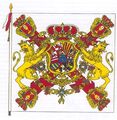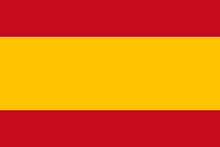1475-1492[]
While the concept of a national flag did not exist in the Middle Ages, the symbol of Spain was the Royal Shield. It was frequently made up of other different flags, full of images and symbols that represented all the values that the troops or the King defended.
In Spain the medieval kingdoms which merged in the sixteenth century had their own heraldic symbols and their navies used to display their own flags and standards on both the Mediterranean Sea and the Atlantic Ocean, where the Aragonese and Castilian Crowns had their respective areas of influence. The flag of the Crown of Aragon was a yellow flag with four red stripes (an element which is still common in the present flags of the territories that formed the Crown: Catalonia, Aragon, Valencian, the Balearic Islands and Roussillon in France). The Crown of Castile, since the final union between the kingdoms of Castile and León in 1230, used a quartered flag alternating the Castilian (Gules, a tower Or, masoned sable and ajouré azure) and Leonese (Argent, a lion rampant purpure crowned or, langued and armed gules) emblems. Aragonese and Castilian flags and coats of arms merged when the Catholic monarchs created the new symbols of their personal union of the crowns in 1475.
The banner of Castile and León was the first European symbol to arrive in the New World.
Cross of Burgundy[]
The Cross of Burgundy is one of the most important flags in the history of Spain, because after the marriage of Joanna of Castile (Joanna the Mad), daughter of the Catholic monarch, to the Archduke of Austria (later Philip I of Castile (Philip the Handsome)), it introduced among Spanish flags a design that, although of foreign origin, would later become the primary Spanish symbol by antonomasia, regardless of the color of the cloth on which it was embroidered (usually white or red).
It is more properly called "Cruz de San Andrés" (Saint Andrew's Cross) or "the Vane of Burgundy".
Habsburg Spain[]
When the House of Habsburg took the Spanish throne by mid-16th century each military company had its own flag in which appeared usually the arms of its commander over the Cross of Burgundy. In order to represent the King, they used to have another one, the "Coronela", during the reign of Charles I (Charles V as Holy Roman Emperor) that was made of yellow silk (the imperial color) with the embroidered imperial shield.
Charles III[]
In 1760 Charles III modified the shield of the Royal arms, suppressing the necklace of the Holy Spirit, maintained the Golden Fleece and added two new quarters, corresponding to the House of Farnese (six blue lilies on gold) and Medici (blue disc with three lilies of gold and five red discs, all on gold).
The military flag or Coronela of Spanish regiments was, during the Bourbon years, the Cross of Burgundy with different additions in each military unit depending on their territorial origin, commander, etc.
When Charles III became King of Spain, he observed that most of the countries in Europe used flags which were predominantly white and, since they were frequently at war with each other, lamentable confusions occurred at sea, it being difficult to determine if a sighted ship were enemy until practically the last moment. For this reason, he ordered to his Minister of the Navy to present several models of flags to him, having to be visible from great distances. The Minister selected twelve sketches which were shown to the king. The flag that was chosen as war ensign is the direct ancestor of the current flag. It was a triband red-yellow-red, of which the yellow band was twice the width of the red bands, a unique feature that distinguished the Spanish tribanded flag from other tribanded European flags. The flag chosen as civil ensign or for Merchant Marine use, meanwhile, consisted of five stripes of yellow-red-yellow-red-yellow, in proportions 1:1:2:1:1.
First Spanish Republic[]
In 1873, Spain Has Adopted Another Flag Before It Restored Kingdom of Spain.
Second Spanish Republic[]
On 14 April 1931, the monarchy was overthrown and replaced by the Second Spanish Republic. The regime change was symbolized by a new tricolor flag, red, yellow and murrey (Spanish: morado), instead of the previous red and yellow bicolor, considered, at the time, monarchist. The purported aim of the murrey strip was to represent Castile and León in the flag's colours, as the existing red and yellow represented the territories of the former Crown of Aragon. The Republican flag was officially adopted on 27 April and officially given to the army on 6 May. Formed by three horizontal strips of the same width, red, yellow and morado, with the coat of arms of the Second Spanish Republic at the center (quarterly of Castile, Leon, Aragon and Navarre, Enté en point for Granada, stamped by a mural crown between the two Pillars of Hercules). Another newness was the smaller dimensions of this flag in its military version, of 1 m x 1 m.
As for the addition of the murrey to represent Castile in the national flag, since the last quarter of the 20th century there are authors that contradict former historians sustaining that the Castilian banner was not murrey, but crimson.
Spain Under Franco[]
1936-1938[]
The Spanish Civil War officially ended on 1 April 1939, when the last Spanish Republican outposts were overrun by the army in revolt. The Republican regime in Spain was destroyed and Francisco Franco became the dictator of the country until his death on 20 November 1975.
On 29 August 1936, the "Junta de Defensa Nacional", issued Decree No. 77, that declared: "The red and gold/yellow bicolour flag is re-established as the flag of Spain", which served as the first flag of Nationalist Spain.
1938-1945[]
This flag was replaced in 1938 by a flag bearing the eagle of John the Evangelist added to the shield. The new arms were allegedly inspired in the coat of arms the Catholic Monarchs adopted after the taking of Granada from the Moors, but replacing the arms of Sicily for those of Navarre and adding the Pillars of Hercules on each flank of the coat of arms. In 1938 the columns were placed outside the wings.
1945-1977[]
On 26 July 1945, the commander's ensigns were suppressed by decree, and on 11 October a detailed regulation of flags was published, that fixed the model of the bi-color flag in use, with a new version of the Saint John eagle. The models established on that decree were in force until 1977.
Spain[]
1977-1981[]
From the death of Franco in 1975, to 1977, the national flag remained that of the 1945 regulation. On 21 January 1977 a new flag was approved that differed from the previous one in that the eagle's wings opened further (the "pasmada" eagle), the Pillars of Hercules were again placed within the wings, and the ribbon with the motto UNA, GRANDE Y LIBRE (ONE, GREAT and FREE) was moved from the eagle's neck to above the eagle's head. Not many flags with this coat of arms were made. Finally, and after the restoration of the House of Bourbon to the Spanish Throne in the person of King Juan Carlos I, the Spanish Constitution of 1978 was published, article 42 section 12 of which reads "The Flag of Spain is formed by three horizontal stripes, red, yellow and red, the yellow being double the width of each of the red ones."
1981-present[]
The Current Flag of Spain is the naval ensign of 1785, Pabellón de la Marina de Guerra under Charles III of Spain. It was chosen by Charles III himself among 12 different flags designed by Antonio Valdés y Bazán (all projected flags were presented in a drawing which is in the Naval Museum of Madrid). The flag remained marine for much of the next 50 years, flying over coastal fortresses, marine barracks and other naval property. During the Peninsular War the flag could also be found on marine regiments fighting inland. Not until 1820 was the first Spanish land unit (The La Princesa Regiment) provided with one and it was not until 1843 that Queen Isabella II of Spain would make the flag official.
This Flag as it is defined in the Spanish Constitution of 1978, consists of three horizontal stripes: red, yellow and red, the yellow stripe being twice the size of each red stripe.
The Spanish coat of arms depicts two crown-topped pillars of Hercules (with red banners displaying the motto in Latin, "PLUS ULTRA," meaning "Future Beyond," alluding to Columbus' discovery of the New World). The two columns flank a shield that displays a castle, a lion wearing a crown, red and yellow vertical stripes, chain mail, and three fleurs-de-lis in an oval in the center. An ornate red and golden crown sits atop the shield.
Design[]
The basic design of the current flag of Spain with the coat of arms is specified by Rule 3 of the Royal decree 1511/1977, that states the following:
- The coat of arms of Spain has a height equal to 2:5 of the hoist (width) and will figure on both sides of the flag.
- When the flag is of regular proportions, having length equal to 3:2 of the width, the coat's axis is placed at a distance from the hoist equal to 1:2 of the flag's width.
- If the flag's length is less than normal, the coat of arms is placed at the center of the flag.
Civil flag and ensign[]
References[]



















